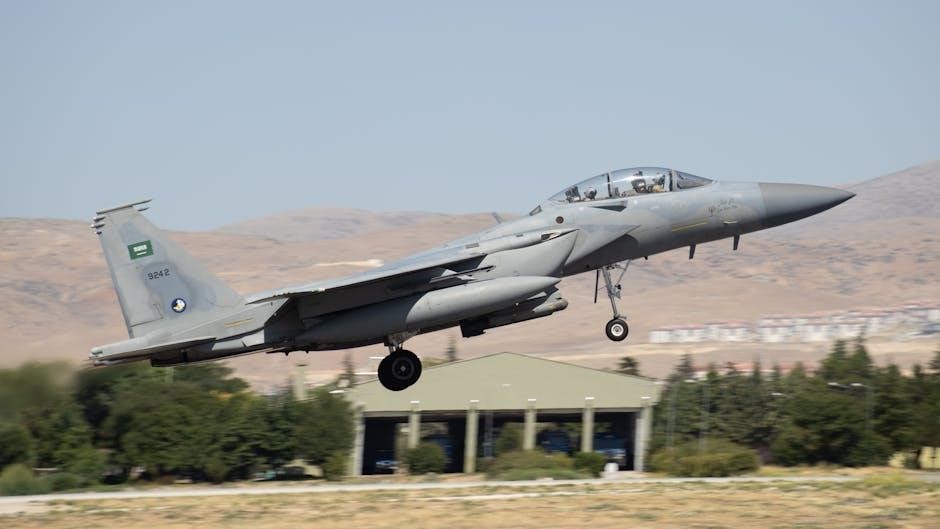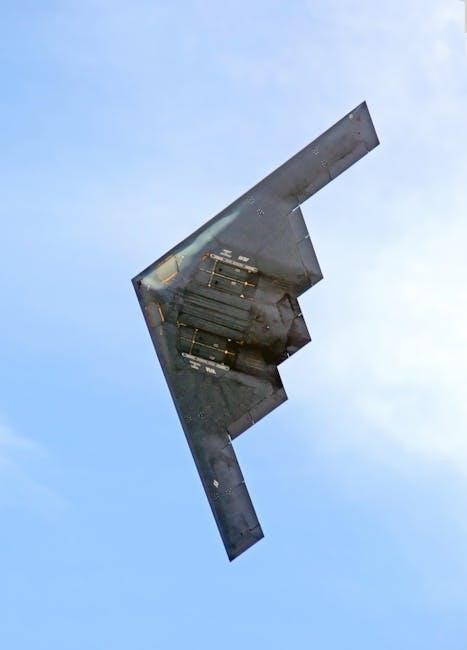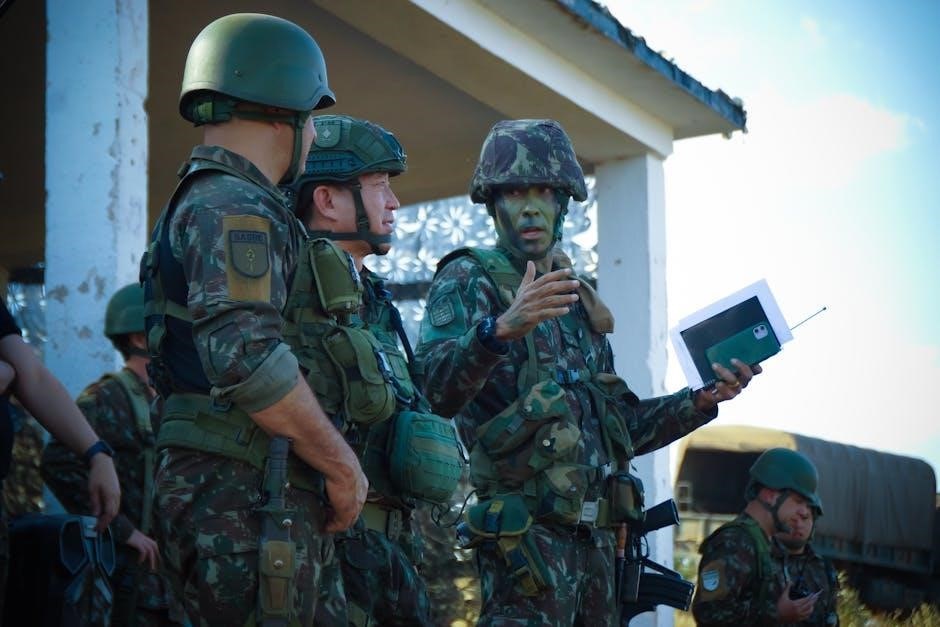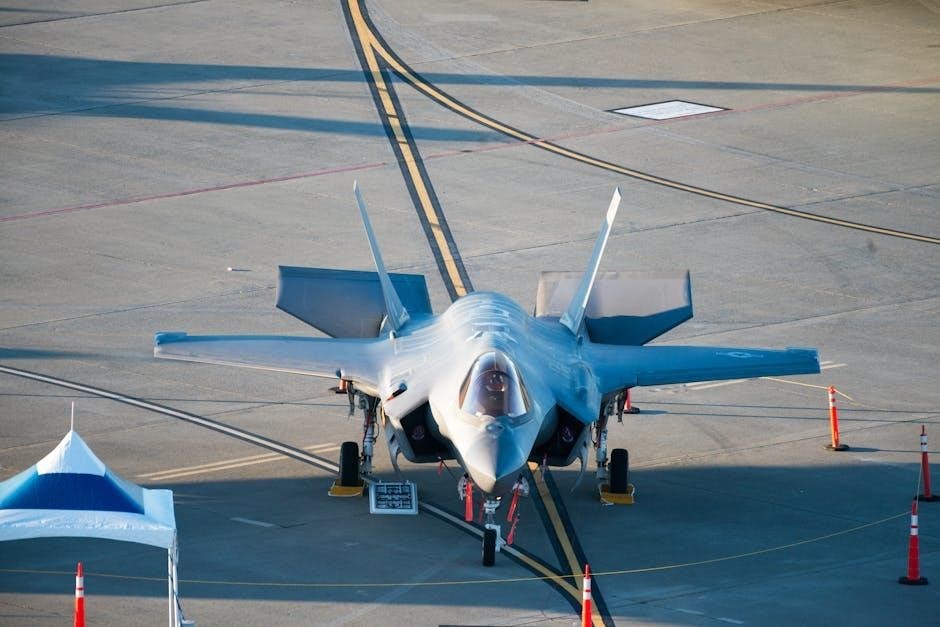The 3-4 defense playbook is a strategic guide outlining the base formation, schemes, and techniques of the 3-4 defensive system. Flexibility and pressure are its hallmarks, making it a popular choice for coaches. With three down linemen and four linebackers, it balances run defense and pass rush, while incorporating man-to-man and zone coverages. This playbook is essential for teams seeking a versatile and aggressive defensive approach.
Overview of the 3-4 Defense
The 3-4 defense is a popular schematic approach in football, characterized by three down linemen and four linebackers. Flexibility and pressure are its cornerstone principles, allowing teams to disrupt offenses through various blitz packages and coverage schemes. This defense excels in stopping both the run and pass, utilizing techniques like zone blitzing and stunts to confuse quarterbacks. The 3-4 is particularly effective when combined with aggressive linebackers and a strong nose tackle, who anchors the defense by occupying double teams. Its versatility makes it a favorite among defensive coordinators, as it can adapt to multiple offensive formations and in-game situations. This system relies on disciplined execution and communication, making it a cornerstone of modern defensive strategies in football.
Importance of a Playbook in Defensive Strategy
A playbook is the backbone of any defensive strategy, serving as a comprehensive guide for players and coaches. It outlines assignments, techniques, and schemes, ensuring everyone is on the same page. In the 3-4 defense, the playbook is crucial for detailing base formations, blitz packages, and coverage responsibilities. It helps players understand their roles and how they contribute to the overall defensive goals. A well-structured playbook also allows for in-game adjustments, enabling quick responses to offensive shifts. Coaches rely on it to prepare for opponents, identify weaknesses, and develop game plans. Without a playbook, communication and execution suffer, making it a vital tool for building a cohesive and effective defense. It’s not just a manual—it’s a roadmap to success on the field.
3-4 Defense Fundamentals

The 3-4 defense relies on versatility and pressure, utilizing three down linemen and four linebackers. It balances run defense with pass rush capabilities, creating disruption through strategic alignments and blitzes.

Base Formation and Alignment
The 3-4 defense begins with a base formation featuring three down linemen and four linebackers. The nose tackle is centrally aligned, flanked by two defensive ends. Inside linebackers are positioned behind the defensive linemen, while outside linebackers align at the edges. This setup provides a strong presence against the run while allowing flexibility for pass rush and coverage. The defensive linemen are typically spaced to occupy blockers, freeing linebackers to flow to the ball. Cornerbacks and safeties round out the secondary, providing support in both run and pass situations. Proper alignment is critical to execute the defense effectively, ensuring each player is in position to fulfill their role within the scheme.
Key Positions: Roles and Responsibilities
In the 3-4 defense, each position plays a vital role. The nose tackle is the anchor, occupying blockers to free linebackers. Defensive ends set the edge and contain plays. Outside linebackers are pass-rush specialists, while inside linebackers act as the defensive quarterbacks, directing the unit and stopping the run. Cornerbacks provide coverage, often in man-to-man or zone schemes, while safeties offer deep support and read the offense. Each player’s responsibilities are clearly defined to ensure cohesive execution of the defense.
Nose Tackle: The Anchor of the Defense
The nose tackle is the cornerstone of the 3-4 defense, requiring a unique combination of size, strength, and technique. Their primary role is to occupy the center and guard, creating gaps for linebackers to flow freely. They must defend the run aggressively and hold their ground against double teams. The nose tackle’s ability to control the line of scrimmage is critical for stopping the run and disrupting the offense’s rhythm. Their presence allows the linebackers to operate unimpeded, making them indispensable to the defense’s success.
In pass-rush situations, the nose tackle may also collapse the pocket, applying pressure on the quarterback. Their versatility and physicality make them a key enforcer in the 3-4 scheme.

Outside Linebackers: The Pass Rush Specialists
Outside linebackers in the 3-4 defense are primarily tasked with pressuring the quarterback, making them the defense’s premier pass-rush threats. Their unique blend of size, speed, and agility allows them to excel in this role. Often lining up on the edges, they utilize advanced techniques such as rip moves, swim moves, and speed rushes to outmaneuver offensive tackles. Additionally, they may drop into coverage or blitz from various angles, creating unpredictability for the offense. Their ability to harass the quarterback is pivotal in disrupting the opponent’s timing and rhythm. Effective outside linebackers are game-changers, capable of single-handedly altering the outcome of plays and forcing turnovers.
Inside Linebackers: The Defensive Quarterbacks
Inside linebackers are the heart of the 3-4 defense, serving as its “defensive quarterbacks.” They are responsible for reading offensive plays, directing teammates, and making split-second decisions. Their primary duties include stopping the run, covering receivers in underneath zones, and blitzing when called. Versatility is key, as they must excel in both physical and mental aspects of the game. Inside linebackers often align behind the defensive line, using their vision to diagnose plays quickly. They must be adept at shedding blocks and pursuing ballcarriers with precision. Additionally, their ability to cover tight ends and running backs in pass coverage makes them indispensable. Effective communication and leadership are essential, as they often call defensive signals and adjust the front line based on offensive alignments; Their performance directly impacts the defense’s overall success, making them a critical component of the 3-4 system.
Cornerbacks and Safeties: Secondary Support
The secondary unit, comprised of cornerbacks and safeties, provides critical support in the 3-4 defense. Cornerbacks are primarily responsible for covering wide receivers in both man-to-man and zone schemes, while safeties offer deep support and act as the last line of defense. Their ability to read the quarterback and react to the ball in the air is crucial. Cornerbacks must excel in press coverage and pattern recognition, while safeties need to patrol the field, providing help over the top and filling gaps in the run game. Effective communication between these positions ensures seamless coverage and minimizes defensive vulnerabilities. Their roles are interchangeable in many schemes, requiring versatility and trust in the system. Together, they form the backbone of the defensive backfield, ensuring the 3-4 defense operates at peak efficiency.

Common Defensive Plays and Strategies
The 3-4 defense employs blitz packages, stunts, and man-to-man or zone coverages to pressure quarterbacks and disrupt offensive timing. These strategies create confusion and exploit weaknesses in the opponent’s scheme effectively.
Man-to-Man and Zone Coverage Schemes
In the 3-4 defense, man-to-man and zone coverage schemes are critical for disrupting opposing offenses. Man-to-man coverage assigns defenders to specific receivers, enabling aggressive play and quick reactions to the quarterback’s decisions. This scheme excels at creating turnovers but requires disciplined technique and trust among defenders. On the other hand, zone coverage focuses on protecting areas of the field, allowing defenders to read the quarterback’s eyes and react to the ball. Zone schemes are particularly effective against the run and short-to-intermediate passes, as they provide overlapping support. By combining these schemes, the 3-4 defense can confuse offenses and limit their effectiveness. Proper communication and alignment are essential to ensure seamless execution of these strategies, making them a cornerstone of the playbook’s success.
Blitz Packages: Creating Pressure
Blitz packages are a cornerstone of the 3-4 defense, designed to create relentless pressure on the quarterback. By utilizing the four linebackers as primary blitzers, defenses can overwhelm offenses with speed and aggression. Inside linebackers often execute delayed blitzes, while outside linebackers attack the edges. These schemes disrupt the quarterback’s rhythm and force quick decisions, leading to sacks or turnovers. Timing and coordination are critical, as blitzes must be precisely timed to avoid leaving gaps in coverage. Additionally, the 3-4 defense incorporates zone blitz concepts, where defensive backs rush while others drop into coverage, adding unpredictability. These strategies not only create chaos but also limit the offense’s ability to exploit weaknesses, making blitz packages a powerful tool in the playbook.
Stunts and Slants: Disrupting the Offense
Stunts and slants are key techniques in the 3-4 defense playbook, designed to disrupt the offense’s blocking schemes and timing. Defensive linemen execute stunts by changing their rush angles, while linebackers use slants to attack specific gaps. These movements create unpredictability, forcing offensive linemen to adjust quickly. Stunts often involve cross-rushing or looping to occupy blockers, freeing up other defenders to pressure the quarterback. Slants, meanwhile, allow defenders to penetrate gaps before the offense can react. When executed correctly, these techniques disrupt the offense’s rhythm, leading to sacks, turnovers, or negative plays. The combination of stunts and slants adds another layer of aggression and complexity to the 3-4 defense, making it difficult for offenses to anticipate and counter the pressure effectively.

Adjustments and Variations
The 3-4 defense playbook incorporates adjustments to counter various offensive schemes, including nickel and dime packages for passing situations and goal-line defenses for short-yardage threats. Flexibility is key.
Adapting to Offensive Formations
The 3-4 defense playbook emphasizes flexibility to counter diverse offensive formations. Against spread offenses, defensive coordinators may employ nickel or dime packages, substituting linebackers for extra defensive backs to improve pass coverage. When facing heavy run formations like the I-Formation or Pro Set, the defense can shift to a more robust alignment, emphasizing gap integrity and stopping the run. The playbook also includes adjustments for motion and formation shifts, ensuring defenders align correctly to neutralize offensive strengths. By adapting pre-snap alignments and post-snap responsibilities, the 3-4 defense can effectively counter any offensive strategy, maintaining balance and discipline while exploiting weaknesses in the opponent’s scheme. This adaptability is a cornerstone of the 3-4 system’s success.
Using Nickel and Dime Packages

Nickel and dime packages are essential in the 3-4 defense playbook for countering passing-heavy offenses. The nickel package replaces a linebacker with a fifth defensive back, enhancing pass coverage in obvious throwing situations. Dime packages go further, substituting a sixth defensive back, providing even greater versatility against multi-receiver sets. These substitutions allow the defense to maintain speed and agility while pressuring the quarterback through blitz schemes. Coaches often deploy these packages on third-and-long or in the red zone to disrupt timing routes and create turnovers. While they sacrifice some run-stopping capability, nickel and dime alignments are crucial for modern pass-dominated offenses, offering a strategic balance between coverage and pressure. Proper execution relies on precise communication and alignment to avoid vulnerabilities in the secondary.

Goal-Line and Short-Yardage Situations
In goal-line and short-yardage situations, the 3-4 defense playbook emphasizes physicality and gap discipline to prevent offensive scores. Defensive linemen must occupy blockers, while linebackers fill run gaps decisively. Safeties often creep closer to the line of scrimmage, creating an extra layer of support. The defense focuses on minimizing movement and staying low to counter the offense’s powerful runs. Coaches may adjust alignments, such as shifting the nose tackle or sliding the linebackers, to plug potential running lanes. Pass coverage in these situations is typically tight, with cornerbacks pressing receivers to disrupt timing. The key is to force the offense into difficult decisions, either through penetration or by bottling up the play. Mental toughness and execution are critical in these high-pressure moments to secure stops and protect the end zone.
Practice and Implementation
Effective practice involves drills targeting defensive skills like tackling, gap discipline, and coverage. Film study helps identify opponent weaknesses, enabling strategic game planning and in-game adjustments.
Drills for Developing Defensive Skills

Drills are essential for refining defensive techniques and building player proficiency. Tackling drills focus on proper form and safety, ensuring players can securely bring down ballcarriers. Footwork exercises improve agility and quickness, crucial for linebackers and defensive backs. Pass-rush drills teach linemen and linebackers how to effectively pressure the quarterback, while coverage drills enhance reaction time and interception skills. These exercises simulate game scenarios, helping players develop muscle memory and instinctive responses. Consistent practice of these drills builds a cohesive and formidable defense, capable of executing the playbook’s strategies effectively.

Game Planning and Film Study
Game planning and film study are critical components of defensive success. Coaches analyze opponents’ strengths, weaknesses, and tendencies to tailor strategies. Film review reveals offensive patterns, such as favorite formations and play-action tendencies, enabling defensive adjustments. By identifying key players and their roles, the defense can anticipate and counter threats. Game plans often include specific blitz packages, coverage schemes, and assignments to exploit weaknesses. For example, if an offense excels at running outside, the defense may reinforce edge support. Film study also helps players recognize pre-snap cues, improving reaction time. This meticulous preparation ensures the defense is well-equipped to execute the playbook effectively and adapt during games, fostering confidence and cohesion. Continuous learning and adaptation are vital for long-term success.
In-Game Adjustments and Communication
In-game adjustments and communication are vital for defensive success. Coaches and players must quickly adapt to offensive strategies, identifying tendencies and exploiting weaknesses. Defensive leaders, such as linebackers, play a crucial role in relaying calls and ensuring alignment. Communication must be clear and concise, often relying on hand signals or coded language to avoid tipping plays. Adjustments may include shifting coverages, altering blitz angles, or stuffing the box against the run. Effective communication fosters unity and execution, allowing the defense to counter offensive schemes dynamically. Trust and precision in these moments are essential for maintaining control and securing stops, especially in high-pressure situations. Strong in-game communication enhances the defense’s ability to adapt and thrive.
The 3-4 defense playbook offers a versatile and strategic framework for defensive success, emphasizing adaptability and teamwork. Continuous learning and refinement ensure its effectiveness in modern football.
Final Thoughts on the 3-4 Defense
The 3-4 defense remains a cornerstone of modern football strategy, offering flexibility and aggression. Its success hinges on player versatility, coordinator expertise, and adaptability. Teams employing this scheme thrive due to its ability to pressure quarterbacks and stop the run. Continuous evolution ensures the 3-4 stays relevant against dynamic offenses. Coaches and players must commit to mastering its complexities, making it a powerful tool for defensive excellence. As football evolves, the 3-4 defense will continue to play a pivotal role in shaping game outcomes.
Continuous Learning and Adaptation
The 3-4 defense demands a commitment to continuous learning and adaptation to remain effective. Coaches and players must study opponents, analyze trends, and evolve strategies to counter modern offenses. Film study and game planning are critical, allowing teams to anticipate and neutralize threats; Adapting schemes to personnel strengths ensures the defense remains dynamic. Incorporating new techniques, such as hybrid players and advanced blitz packages, keeps the playbook fresh. Collaboration between coaches and players fosters innovation, ensuring the 3-4 defense stays ahead of offensive innovations. In football’s ever-changing landscape, adaptability is key to sustained success, making the 3-4 defense a timeless and versatile system.
